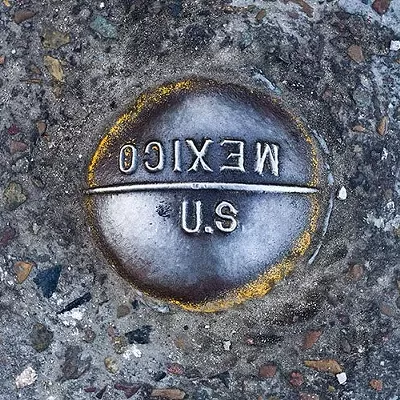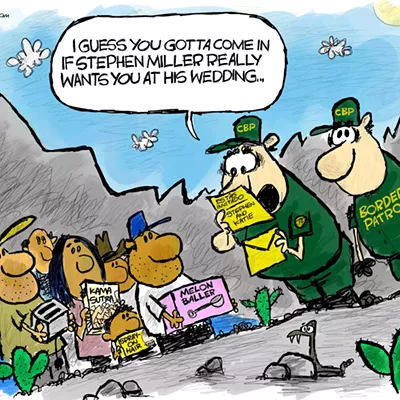It started in May, when the Government Accounting Office (GAO) issued its report to Congress on alien smuggling. Former Border Patrol Tucson Sector Chief Ron Sanders told the Weekly that the GAO report on the Immigration and Naturalization Service was "much too kind."
"The GAO has always been gentle with the INS," said Sanders.
But if the GAO was "kind," its report did find agency-wide ineptitude.
The GAO found alien smuggling investigative efforts to be fragmented and uncoordinated, lacking even basic criteria by which the INS could determine which investigations it should open and pursue.
Furthermore, the INS lacks an agency-wide, automated case-tracking and management system that could contain information on current as well as previous investigations. An automated system would help to eliminate duplicate investigations and would facilitate sharing information with other agencies.
Another criticism: INS uses a narrative rather than a computer-database format for reporting intelligence information, and lacks coordination with other anti-smuggling agencies.
Then, in late June, the House Appropriations Committee lambasted the INS for the release of 35,319 criminal aliens back into the community.
Many of these people, the committee believes, "should have been deported, of whom 11,605 (37 percent) were later arrested for additional crimes, including 3,847 for drug related crimes, 98 for homicide, 142 for sexual assault, 44 for kidnapping, 347 for robbery and 1,214 for assault."
At home, Border Patrol chief David Aguilar told the Weekly that his sector boasts the highest smuggler prosecution rate (98 percent) of any sector in the U.S.
But when the Weekly asked about criminal felony prosecutions for smuggling illegal entrants into the U.S., the stats and the bravado from the sector HQ melted down.
Smuggling cases fall into two basic categories: those made by uniformed patrol agents, and those made by the sector's 15-person Anti Smuggling Unit (ASU).
The Border Patrol, even after several statistical releases to the Weekly, couldn't come up with prosecution stats for the Anti Smuggling Unit. Border Patrol informants estimate that ASU undercover agents are lucky to have three felony prosecutions a year. (Smuggling is a felony; mere illegal entry into the U.S. is a misdemeanor.)
Statistics provided by assistant chief Robert J. Hines for fiscal year 1999 show that uniformed agents--in contrast to the specialized Anti Smuggling Unit--presented 3,402 processed and investigated cases to the U.S. Attorney in Tucson for felony prosecution. But the U.S. Attorney "flipped" 2,255 of the cases, allowing the incarcerated prisoners to instead plead to a misdemeanor charge.
The misdemeanor plea will appear as a conviction, but, in reality, it is nothing more than a slap on the wrist. The perpetrator will, more often than not, walk with time served.
In fiscal year 2000, only 946 cases were prosecuted as felonies in the Tucson Sector, while an astounding 3,057 were "flipped" to allow misdemeanor pleas. Hines didn't have the actual number of successful prosecutions in his case-tracking system.
Patrol agents have provided the Weekly examples of some cases "flipped" to misdemeanors.
When Border Patrol agents in the Tucson Sector arrested Alberto Torres-Campos for the fourth time as the driver of an "alien smuggling load"--a vehicle carrying illegal entrants--they thought he would be prosecuted as a felon by the U.S. Attorney's office. They were wrong. The U.S. Attorney in Tucson reduced the felony charges to a misdemeanor, even though internal Border Patrol records show Torres-Campos was arrested on 13 previous occasions. Torres-Campos pled guilty to the lesser charge and walked.
Border agents say the Torres-Campos case is not unusual. In fact, they say, that sort of thing happens all the time.
Agents provided several other examples of individuals arrested by the Border Patrol as smuggling suspects who were investigated and turned over to the U.S. Attorney for felony prosecution.
Felony charges were also declined by the U.S. Attorney and reduced to a misdemeanor for Pablo Narajo-Calderon, who was arrested with two illegal aliens in the trunk of his car.
On February 25, 1999, Jose Perez was arrested as the driver of a load vehicle. The car he was driving crashed, killing a passenger, an illegal alien. When uniformed agents of the Border Patrol arrested Perez and ran his prints through IDENT, the fingerprint system used by the Immigration and Naturalization Service, IDENT blinked, showing Perez was arrested 14 previous times. Although Perez was initially charged with manslaughter, Tucson-based U.S. Attorney Tom Fink reduced the charges to a misdemeanor.
Then there is the case of Timoteo Juarez-Bravo, who was arrested by the Arizona Highway Patrol when the overloaded vehicle he was driving had a blowout. The vehicle contained 10 illegal aliens. His records showed he had been arrested 10 times previously. Juarez-Bravo had, at the time of his arrest, misdemeanor convictions for false information, driving without a license and trespass. Yet the felony charges investigated by patrol agents and presented to the U.S. Attorney were reduced to a misdemeanor.
UNTIL THIS WEEK, uniformed agents of the Border Patrol operating along the Arizona Mexican border have had significant success targeting smugglers and seizing their load vehicles. But since a new federal law took effect on August 23, that may all change.
Under the new law, the Civil Asset Forfeiture Reform Act of 2000, winning in court will be a lot harder for the Border Patrol. In fact, the Border Patrol may not even be motivated to try.
The law, which was introduced by Representative Henry Hyde, a Republican from Illinois, shifts the burden of proof to the government. The U.S. Attorney must now provide the court with a preponderance of evidence that the load vehicle's owner or driver had "prior knowledge" that the vehicle in question was being used for illegal (smuggling) purposes.
Until now, U.S. law allowed agents to use probable cause as a means by which a suspected vehicle loaded with illegal aliens could be seized, forfeited and taken off the road. Probable cause is now toast.
The new law also changes the requirement for posting bond. The owner-driver will no longer be required to post bond for the value of the vehicle. Furthermore, should the Border Patrol lose a case under the new law, the government would automatically be liable for attorney fees.
Tucson Sector Assistant Chief Ted Swofford, who is in charge of the Asset Forfeiture Office, says the new law will not help take smugglers off the road.
Indeed. In preparation for it, agents in the Tucson Sector are scaling back their vehicle seizure operations. Tucson Sector agents seized 784 vehicles in January and 643 in February, but in anticipation of the strict requirements of the forfeiture act, agents scaled back to 220 vehicle seizures in July.
And, thus far in August, only one vehicle has been seized by the Border Patrol.
Needless to say, vehicles left along the side of a road could pose both safety and liability issues, said Swafford. "At this time we don't even know who will be responsible for the towing and storing of seized vehicles," he said.
Chief David Aguilar explained that every smuggling operation needs four basic organizational elements in place to guarantee success: staging, communications, transportation and stash houses. Disrupting any one of these basic elements would upset (but not close down) smugglers operating along the U.S.-Mexico border and throughout the interior of Arizona.
Up until this week, taking away the smugglers' load vehicles has been a major piece of the Patrol's strategy. Now, in lieu of snatching the smugglers' transportation, maybe the Tucson Sector will have to persuade the U.S. Attorney to prosecute the smugglers themselves.










